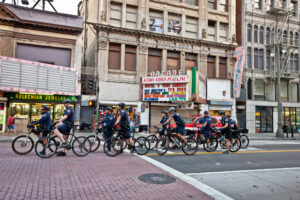
311 Service Requests
Learn More Metadata Download the Dataset View on Map Variable Definitions:Total 311 Call Rate: The number of 311 service requests made by community residents per
Variable Definitions:
Stop Rates
Total Stop Rate: The number of police stops of a vehicle or pedestrian per 10,000 people in the resident population
Pedestrian Stop Rate: The number of police stops of a pedestrian per 10,000 people in the resident population
Vehicle Stop Rate: The number of police stops of a vehicle per 10,000 people in the resident population
Stop by Race
Black Stops: The percentage of individuals stopped by police where the person stopped was identified as Black/African American
Hispanic/Latino Stops: The percentage of individuals stopped by police where the person stopped was identified as Hispanic/Latino
White Stops: The percentage of individuals stopped by police where the person stopped was identified as White
Other Stops: The percentage of individuals stopped by police where the person stopped was identified as a race/ethnicity other than Black, Latino or White
Source:
Stop Counts: Los Angeles Police Department (LAPD)
Resident Population: American Community Survey, 5-year estimates
Years Available:
2011 – 2023
These variables count one stop for each separate individual stopped by an officer. The data includes a number of different stop types, including pedestrian, vehicle stops, terry stops (also known as “stop and frisk”), and searches. The data includes stops reported by the Los Angeles Police Department (LAPD) in LAPD reporting districts within the City of Los Angeles.
Stops are the most common way that police directly initiate contact with citizens and have been shown to cause harmful trauma to some people stopped. After a stop occurs, there are multiple possible outcomes. Most commonly, nothing happens; however, an arrest, issuance of a citation, or warning are also possible outcomes of a stop. In 2015, the state of California passed AB 953 which mandates that stops data be collected and analyzed across the state to look for racial bias. The LAPD have been collecting and publishing their stops data since 2011, making them unique among large law enforcement agencies in Southern California.
Stops can be influenced by several factors, most of which point to systematic issues within policing.
Written by Caroline Ghanbary
Citations:
Abate, T. (2020, May 5). Black drivers get pulled over by police less at night when their race is obscured by ‘veil of darkness,’ Stanford study finds. Stanford Report. Link.
Conarck, B. (2023, February 8). Leaked docs: State police use quota-like system to reward arrests, issue new vehicles. The Baltimore Banner. Link.
KCAL News. (2011, April 12). $2M Awarded To LAPD Officers Who Alleged Ticket Quota. CBS News. Link.
KCAL News. (2023, December 10). City Approves $6M Settlement In Ticket Quota Suit Brought By LAPD Traffic Patrol Officers. CBS News. Link.
Poston, B. (2019, October 13). After Times investigation, LAPD to make changes to Metro Division. Los Angeles Times. Link.

Learn More Metadata Download the Dataset View on Map Variable Definitions:Total 311 Call Rate: The number of 311 service requests made by community residents per

There are disparities present in how the justice system treats communities of color, including the Latino population. These disparities are greatest for Black populations, which

This story was created as a part of the NDSC Criminal Justice Data Initiative. In the spring of 2019, the USC Price Center partnered with
